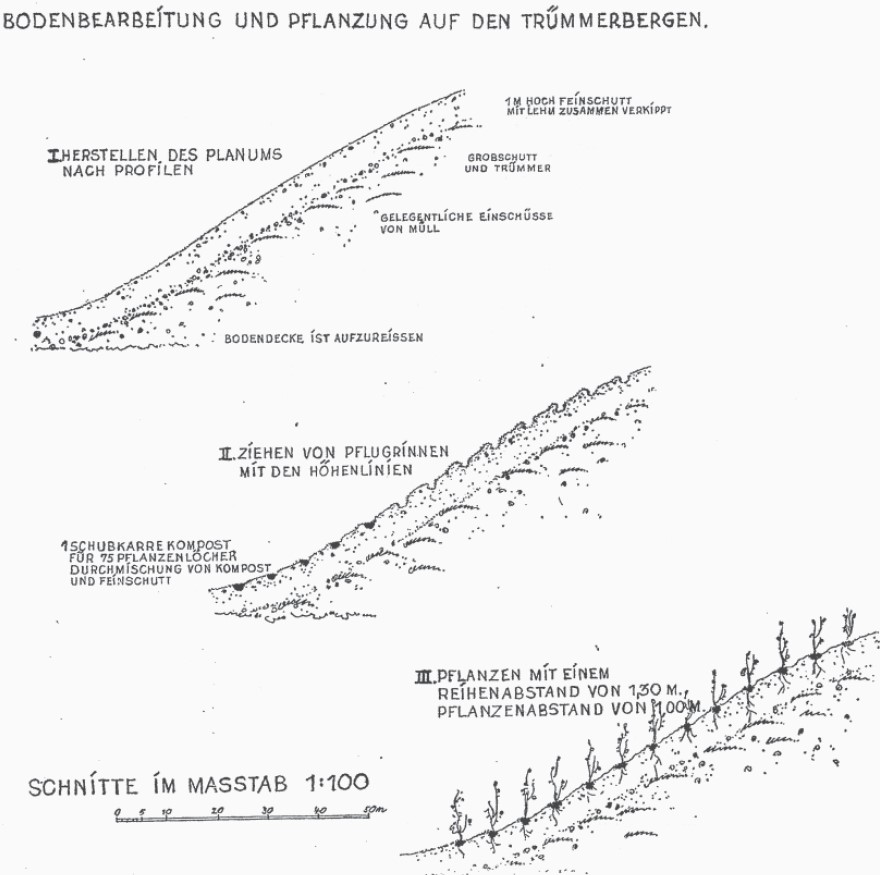Topsoil
“ In barren, desolate grounds, what does it take to give flora a chance to grow?”
Although there are various definitions of topsoil, they all represent some of the most nutritious and physically supportive parts of a soil layer, from the perspective of various plants.”1 Topsoil is generally recognized as the uppermost and outermost few centimeters of soil, also referred to as the “A horizon.” Darkened in color by its high concentration of organic material, it has the greatest amount of biological activity and nutrients, in comparison with other types of soil. Topsoil makes the ground suitable for vegetation to grow, independently of what the layer below, or subsoil, consists of. After a plant has developed past a certain stage of maturation, the criticality of topsoil in sustaining that plant may wane, depending on the species of that plant.
This is illustrated by the principle section of a Trümmerberg, designed by Reinhold Lingner, director of the 1945 Berliner Hauptamtes für Grünplanung (Berlin Main Department of Green-Space Planning and Horticulture)2. The rubble that resulted from the Allied bombings and Soviet siege of Berlin from World War II, was piled up into hills in and around the city. The composition of the matter, including various materials such as concrete, sandstone, plastics, and chemical waste, differed greatly from natural soil, leading to characteristics such as extraordinarily high water permeability that discouraged plant growth.
In order to create favorable conditions for vegetation, the hills were covered with a layer of topsoil, and a greening process was introduced. Pioneer plants were introduced onto the hills, in order to start the process of waste remediation, and visual unification with the existing topography of the city.As topsoil was still expensive and scarce after the creation of these rubble hills, the upper layer of soil present on site was later excavated for other uses after vegetation had reached a suitable level of maturation and root-depth.
![]() Image source:
Forßbohm, Ulrike. ‘Kriegs-End-Moränen - Zum Denkmalwert Der Trümmerberge in Berlin’. Technische Universität Berlin, 2009.
Image source:
Forßbohm, Ulrike. ‘Kriegs-End-Moränen - Zum Denkmalwert Der Trümmerberge in Berlin’. Technische Universität Berlin, 2009.
References
1. Darmody, R. G., W. L. Daniels, J. C. Marlin, and D. L. Cremeens. ‘Topsoil: What Is It and Who Cares?’ Revitalizing the Environment: Proven Solutions and Innovative Approaches, 2009, 237–69.
2. Forßbohm, Ulrike. ‘Kriegs-End-Moränen - Zum Denkmalwert Der Trümmerberge in Berlin’. Technische Universität Berlin, 2009.
1. Darmody, R. G., W. L. Daniels, J. C. Marlin, and D. L. Cremeens. ‘Topsoil: What Is It and Who Cares?’ Revitalizing the Environment: Proven Solutions and Innovative Approaches, 2009, 237–69.
2. Forßbohm, Ulrike. ‘Kriegs-End-Moränen - Zum Denkmalwert Der Trümmerberge in Berlin’. Technische Universität Berlin, 2009.
 Image source:
Forßbohm, Ulrike. ‘Kriegs-End-Moränen - Zum Denkmalwert Der Trümmerberge in Berlin’. Technische Universität Berlin, 2009.
Image source:
Forßbohm, Ulrike. ‘Kriegs-End-Moränen - Zum Denkmalwert Der Trümmerberge in Berlin’. Technische Universität Berlin, 2009.